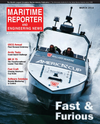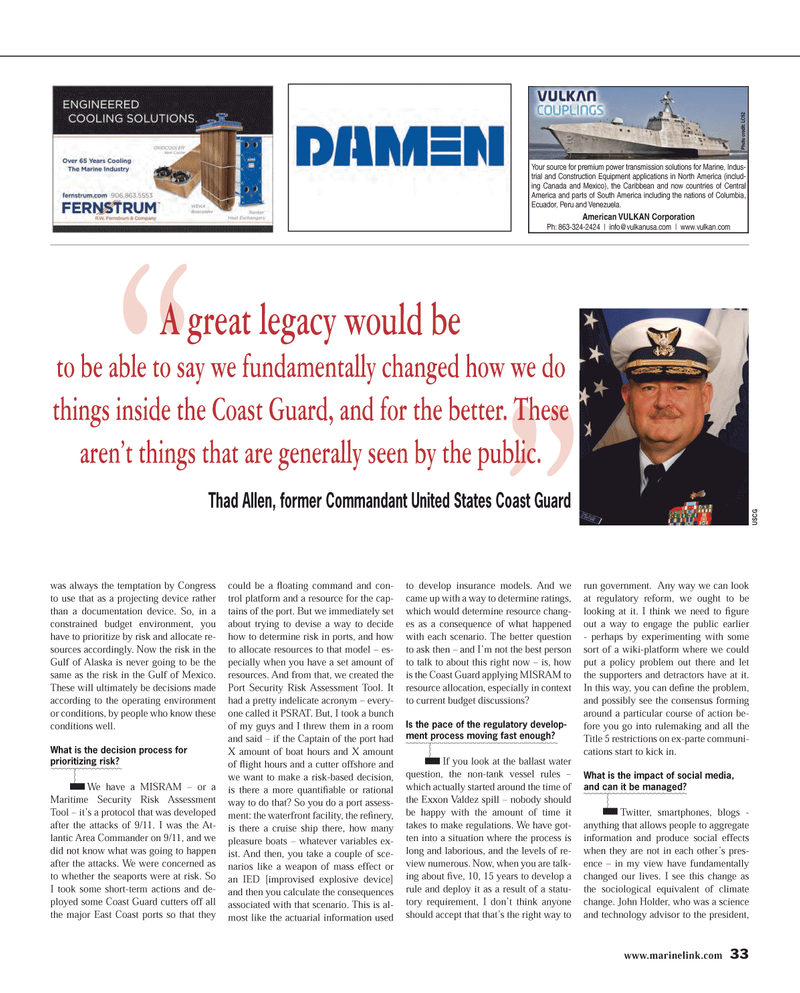
Page 33: of Maritime Reporter Magazine (March 2014)
U.S. Coast Guard Annual
Read this page in Pdf, Flash or Html5 edition of March 2014 Maritime Reporter Magazine
www.marinelink.com 33 ” “ was always the temptation by Congress to use that as a projecting device rather than a documentation device. So, in a constrained budget environment, you have to prioritize by risk and allocate re- sources accordingly. Now the risk in the
Gulf of Alaska is never going to be the same as the risk in the Gulf of Mexico.
These will ultimately be decisions made according to the operating environment or conditions, by people who know these conditions well.
What is the decision process for prioritizing risk? We have a MISRAM – or a
Maritime Security Risk Assessment
Tool – it’s a protocol that was developed after the attacks of 9/11. I was the At- lantic Area Commander on 9/11, and we did not know what was going to happen after the attacks. We were concerned as to whether the seaports were at risk. So
I took some short-term actions and de- ployed some Coast Guard cutters off all the major East Coast ports so that they could be a fl oating command and con- trol platform and a resource for the cap- tains of the port. But we immediately set about trying to devise a way to decide how to determine risk in ports, and how to allocate resources to that model – es- pecially when you have a set amount of resources. And from that, we created the
Port Security Risk Assessment Tool. It had a pretty indelicate acronym – every- one called it PSRAT. But, I took a bunch of my guys and I threw them in a room and said – if the Captain of the port had
X amount of boat hours and X amount of fl ight hours and a cutter offshore and we want to make a risk-based decision, is there a more quantifi able or rational way to do that? So you do a port assess- ment: the waterfront facility, the refi nery, is there a cruise ship there, how many pleasure boats – whatever variables ex- ist. And then, you take a couple of sce- narios like a weapon of mass effect or an IED [improvised explosive device] and then you calculate the consequences associated with that scenario. This is al- most like the actuarial information used to develop insurance models. And we came up with a way to determine ratings, which would determine resource chang- es as a consequence of what happened with each scenario. The better question to ask then – and I’m not the best person to talk to about this right now – is, how is the Coast Guard applying MISRAM to resource allocation, especially in context to current budget discussions?
Is the pace of the regulatory develop- ment process moving fast enough? If you look at the ballast water question, the non-tank vessel rules – which actually started around the time of the Exxon Valdez spill – nobody should be happy with the amount of time it takes to make regulations. We have got- ten into a situation where the process is long and laborious, and the levels of re- view numerous. Now, when you are talk- ing about fi ve, 10, 15 years to develop a rule and deploy it as a result of a statu- tory requirement, I don’t think anyone should accept that that’s the right way to run government. Any way we can look at regulatory reform, we ought to be looking at it. I think we need to fi gure out a way to engage the public earlier - perhaps by experimenting with some sort of a wiki-platform where we could put a policy problem out there and let the supporters and detractors have at it.
In this way, you can defi ne the problem, and possibly see the consensus forming around a particular course of action be- fore you go into rulemaking and all the
Title 5 restrictions on ex-parte communi- cations start to kick in.
What is the impact of social media, and can it be managed? Twitter, smartphones, blogs - anything that allows people to aggregate information and produce social effects when they are not in each other’s pres- ence – in my view have fundamentally changed our lives. I see this change as the sociological equivalent of climate change. John Holder, who was a science and technology advisor to the president,
American VULKAN Corporation
Ph: 863-324-2424 | [email protected] | www.vulkan.com
Your source for premium power transmission solutions for Marine, Indus- trial and Construction Equipment applications in North America (includ- ing Canada and Mexico), the Caribbean and now countries of Central
America and parts of South America including the nations of Columbia,
Ecuador, Peru and Venezuela.
Photo credit: LCS2
American Vulkan MR Jan14.indd 1 12/19/2013 9:55:54 AM
A great legacy would be to be able to say we fundamentally changed how we do things inside the Coast Guard, and for the better. These aren’t things that are generally seen by the public.
Thad Allen, former Commandant United States Coast Guard
USCG
MR #3 (32-41).indd 33 3/4/2014 10:50:50 AM

 32
32

 34
34
